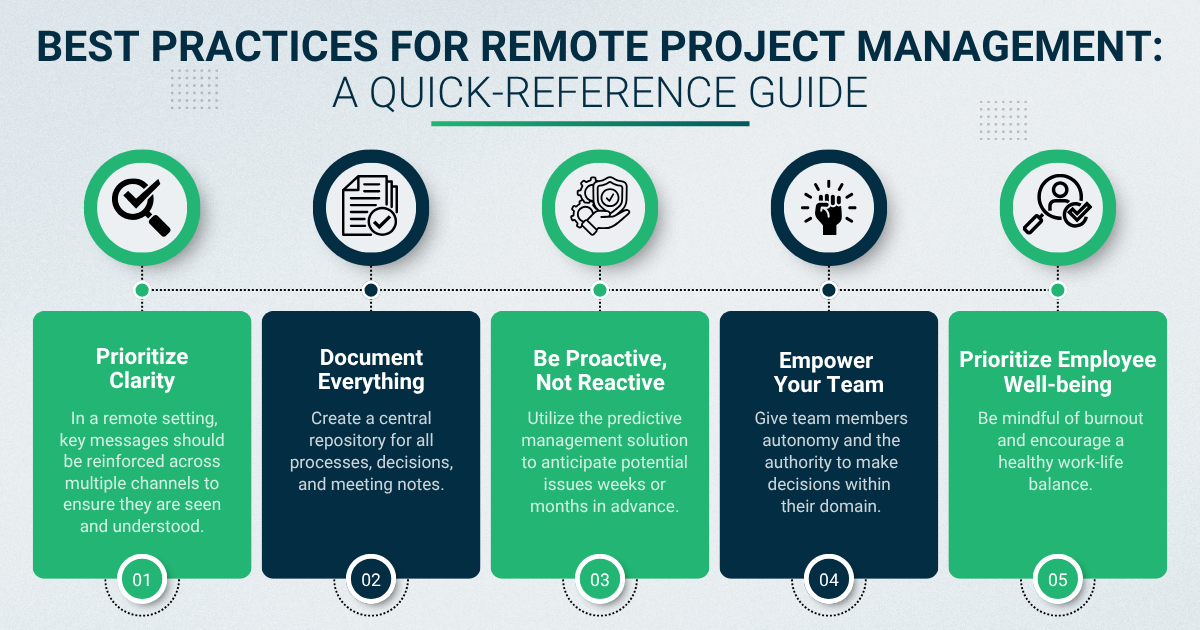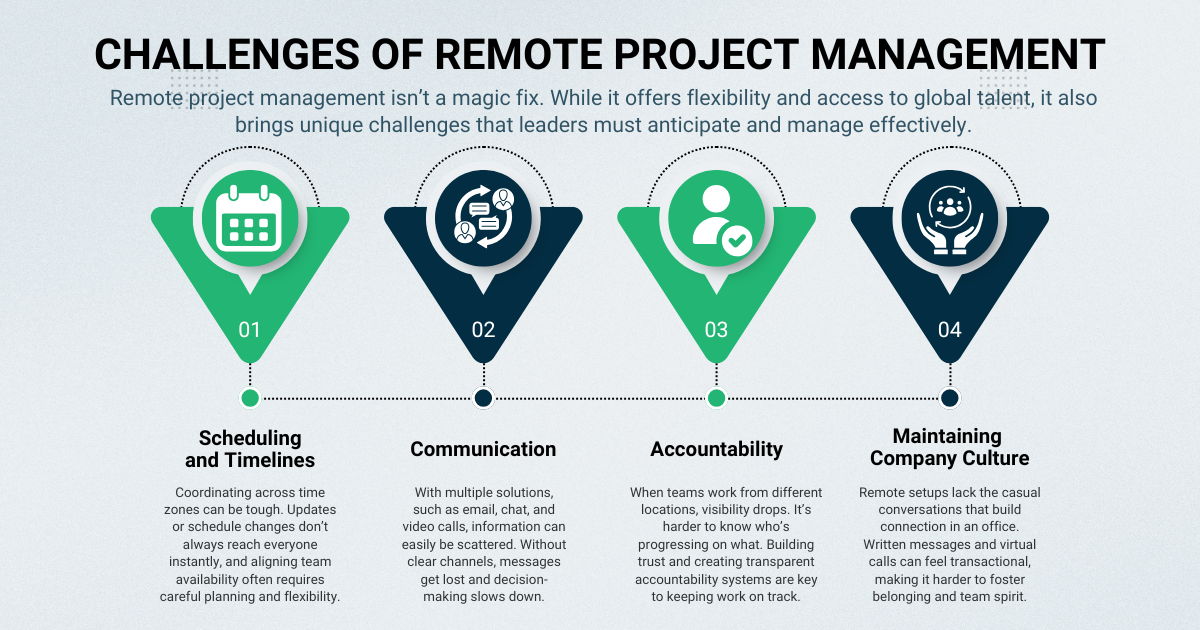
Quick Summary: As remote and hybrid work redefine how teams operate, traditional project management struggles to keep up with invisible risks and fading visibility. The most effective leaders aren’t adding more meetings; they’re relying on predictive project management to read subtle signals early, align distributed teams, and prevent minor issues from becoming major setbacks.
Remote Project Management: Why Predictive Intelligence Matters Now
The way we work has shifted irrevocably. Today, approximately 61% of project professionals work remotely at least part of the time. This isn’t a temporary experiment. Remote and hybrid models are becoming the default in many organizations. In fact, according to the 2024 Pulse of the Profession report, hybrid delivery approaches (combining remote, on-site, and flexible methods) have increased from 20% in 2020 to 31% in 2023.
Yet managing a remote project is more than disbursing tasks across time zones. While offering unparalleled access to global talent and increased flexibility, managing distributed teams introduces a unique set of challenges, including communication silos, collaboration hurdles, and a lack of project visibility. Studies reveal that poor communication contributes to project failures in up to 30% of cases. The stakes are high; projects that succeed on time, on budget, and on scope remain fewer than half of all initiatives.
It requires proactive communication, emotional intelligence, and clear accountability. That’s where predictive project management comes in. Instead of relying on lagging indicators or holding more meetings, predictive approaches continuously integrate stakeholder feedback and proven patterns to identify early-warning signals. They highlight where sentiment is drifting, where decisions are stalling, and where requirements are unstable, often weeks ahead of visible slippage.
This comprehensive guide explores the key strategies, solutions, and methodologies for successful remote project management. We will explore how to build cohesive teams, maintain momentum, and, most critically, leverage the predictive project management solutions to gain foresight and ensure project health in a virtual world.
What Is Remote Project Management?
Remote project management is the discipline of planning, executing, and closing projects with team members who are not physically co-located. It transcends geography, representing a fundamental shift in leadership, communication, and operational style. Unlike traditional models that rely on face-to-face interaction and visible cues, remote project management necessitates a deliberate, technology-enabled, and trust-based framework.
The core objective remains the same: to deliver projects on time, within scope, and on budget. However, the path to achieving this objective requires a new set of disciplines and tools designed to bridge the digital divide. So, how do you lead, measure, and maintain momentum when your team spans cities, countries, or even continents? That question captures the essence of remote project management today.
The Remote Project Management Landscape in 2025
Remote work is the standard operating mode for modern organizations today. In 2025, nearly 22% of the U.S. workforce (approximately 32.6 million people) works remotely full-time, and 83% of employees report that a hybrid setup, a combination of office and remote work, is their preferred model.
What began as a forced adjustment has matured into a strategic advantage. Yet, it has also exposed a truth that most leaders now face: managing remotely isn’t just “business as usual” on Zoom. It’s a complete rethinking of how teams communicate, collaborate, and stay aligned. Time zones stretch the workday, written messages replace hallway chats, and a project’s pulse isn’t as easy to read as it once was. When people work asynchronously, the challenge isn’t productivity; it’s visibility. You can’t fix what you can’t see.
That’s why distributed team management today is less about location and more about clarity, rhythm, and foresight. Successful leaders are building new habits, documenting decisions, setting transparent expectations, and using data-driven insight to stay connected to what’s really happening across their teams.
As organizations adapt to this new rhythm of work, one truth is becoming clear: a remote project is a catalyst for progress.
You can’t fix what you can’t see. Discover how to change that. Gain the visibility and foresight your remote teams need to thrive. Learn More.

Why Remote Project Management is Here to Stay: The Data-Backed Benefits
Remote project management offers numerous benefits to organizations. It simplifies planning and task delegation, enabling teams to clearly understand project scopes and schedules and making task assignments more efficient. Here are some of the advantages of remote project management for your company:
- Access to a Global Talent Pool: Remote project management eliminates geographic restrictions, enabling organizations to recruit top talent worldwide. Companies adopting remote work report savings of around US$11,000 per remote employee per year from reduced overhead (office space, utilities, supplies). Some firms report cutting real estate costs by 25%–30 % once a remote or hybrid model is in place.
- Flexibility that Drives Performance: Remote work empowers people to operate from environments where they feel most focused and productive. The ability to align work with personal rhythms enhances motivation, reduces burnout, and supports a healthier work-life balance, leading to consistent, high-quality output.
- Cost Efficiency and Scalability: Organizations and enterprises can significantly reduce expenses related to office space, utilities, and maintenance. These savings can be redirected toward innovation and growth, while the organization’s geographic reach expands, opening doors to new clients and business opportunities.
- Sustainability in Action: With fewer commutes and reduced energy use, remote project management contributes to lower carbon emissions and a smaller environmental footprint. This shift not only supports sustainability goals but also aligns with modern corporate values around social responsibility.
- Empowerment through Trust: Successfully managing remote teams requires a culture built on trust and accountability. When project managers prioritize communication, empathy, and transparency, teams feel valued and empowered—turning distance into collaboration and challenge into opportunity.
The rise of remote collaboration has redefined how teams work, but it has also exposed the limits of conventional project management in a digital-first world.

Why Traditional Project Management Approaches Fall Short Remotely
Traditional project management depends on proximity. When teams share a workspace, leaders naturally pick up cues, such as a quick desk chat, a tense tone, or a sigh, during a meeting. Those subtle signs often reveal more than any dashboard can. But in a remote setting, those signals vanish.
To compensate, many managers schedule more meetings, send more reports, and track more metrics. Yet, none of it truly restores what’s missing, the ability to sense problems before they surface. Dashboards show what’s already happened, not what’s about to. By the time performance metrics turn red, projects are already behind.
In a distributed world, the real risks are invisible: a confused stakeholder, a stalled decision, a dependency lost in a thread. Without early visibility, these issues quietly build up until deadlines slip and teams burn out trying to catch up.
This is where predictive project management changes the story. It moves leaders from reacting after the fact to anticipating before impact, using behavioral patterns, engagement signals, and delivery data to highlight where attention is needed most. Remote teams don’t need more check-ins; they need smarter insight. Predictive approaches make that possible.
So, how do leaders regain that missing visibility, seeing beyond the dashboards and into the future of their projects? The answer lies in predictive intelligence powered by AI.
If you’re only tracking what’s happened, you’re already behind. Discover how predictive intelligence helps you stay two steps ahead. Request a Demo.

Role of AI-Enabled Predictive Intelligence in Remote Project Management
AI-powered predictive intelligence technology revolutionizes your remote project management processes by offering valuable project insights and automating mundane tasks. Unlike standard project management software, which tracks tasks, the predictive project management solution utilizes a sophisticated algorithm to generate a predictive health score. Here’s how it directly addresses the core challenges of remote project management:
- Centralized Predictive Health Score: The solution consolidates data from various sources into a single, easy-to-understand health score. This gives remote managers and stakeholders an instant, objective view of project status, eliminating guesswork and misinterpretation.
- Objective Data Over Subjective Opinion: In a remote setup, it's hard to "get a feel" for how things are going. The modern predictive intelligence technology replaces gut feelings with data-driven decision-making power, providing an unbiased assessment of project health that everyone can trust.
- Proactive Risk Identification: The solution highlights specific areas of concern, whether in scheduling, resources, or requirements, allowing managers to intervene early with their remote team, before a minor issue becomes a major crisis.
- Enhanced Stakeholder Reporting: The technology also generates clear, concise, and data-rich reports that are perfect for keeping remote stakeholders, executives, and clients informed and confident in the project's direction.
Predictive intelligence provides the visibility leaders need, but realizing its full potential demands an equally strategic approach to organizing and guiding remote teams.
What’s the best way to manage a remote project team effectively?
To achieve remote project management success, keeping your work well organized and visible is essential for staying on course. It's crucial that everyone on your team can easily access the project plan, understand their assignments, and know their responsibilities. However, before organizing work activities, assembling a remote project team is crucial. The following steps will guide you in making a highly productive remote team.
- Understand Your Remote Structure: First, you need to be clear about the type of remote setup you're dealing with. Different remote structures require different approaches.
- Find the Right People: Seek out candidates whose skills align with your project's needs. But don't stop there; look for individuals who are also excellent communicators and responsive to messages and updates.
- Set Clear Guidelines: Ensure that your team understands the rules of engagement. This includes defining work hours, the frequency of check-ins, time tracking, project goals, and who has authority over specific tasks.
- Stay Connected: Keep the team engaged through virtual meetings and chat platforms. It's essential to maintain that sense of connection, even if you're miles apart.
- Establish Reliable Communication Channels: Ensure everyone is on the same page regarding communication. Whether it's for direct chat, announcements, or feedback, having a dependable channel is crucial. The integration of predictive analytics in remote project management enables real-time tracking of project progress.
- Utilize Collaboration Solutions: Invest in the predictive project management solution that enables your project team to work seamlessly, regardless of their locations. These solutions allow for seamless task allocation, progress tracking, file sharing, and real-time data visualization.
- Implement Remote Project Management Solutions: Solutions like timesheets help track the amount of time team members dedicate to specific tasks, ensuring accountability within the team.
A strong remote team may power execution, but it’s predictive intelligence that powers foresight, turning good project management into exceptional outcomes.
The Conclusion
Remote project management presents both unique challenges and tremendous opportunities for organizations in today's dynamic work environment. While it offers cost savings, enhanced productivity, and access to top talent, it also demands solutions to overcome hurdles such as scheduling, communication, accountability, and maintaining a company culture. Embracing technology, particularly AI-enabled predictive intelligence, can be a game-changer in overcoming these challenges. It is here that TrueProject, a predictive intelligence solution for project health and performance, plays a critical role. The solution helps you plan your project. How, you ask?
You can view planning details of similar projects through historical project data, findings, and analysis that were created and executed in the past. Furthermore, you can compare the present project to past performance and capture and review project diary entries. Often, remote project managers spend a significant amount of their time collecting data and preparing reports. With TrueProject, the collection, reporting, and analysis are done automatically.
As remote work reshapes the modern business landscape, proactive adaptation and strategic utilization of technology are paramount. By embracing the role of AI-enabled predictive intelligence and implementing robust remote project management practices, organizations can not only overcome challenges but also thrive in an increasingly interconnected and dynamic global marketplace.
Turn hindsight into foresight with TrueProject. Discover how predictive intelligence enhances remote project planning with precision and accuracy. Get Your Snapshot.
FAQs: Remote Project Management & Predictive Oversight
1. What is the best way to manage remote projects across time zones?
Adopt an asynchronous-first approach: document updates, decisions, and dependencies to prevent work from stalling due to overlapping hours. Use predictive analytics to monitor decision latency and dependency risks — they’ll tell you where time zones are quietly slowing delivery.
2. Can predictive project management reduce risk in distributed teams?
Absolutely. Predictive project management continuously analyzes stakeholder feedback, team sentiment, and delivery trends to identify and address issues before they escalate. It replaces reactive firefighting with proactive, data-driven control.
3. Which KPIs are most useful for remote delivery?
Leading indicators matter most: stakeholder sentiment, decision latency, dependency risk, and communication responsiveness. Traditional lagging metrics, such as cost variance or milestone adherence, should still be tracked but interpreted in the context of these predictive signals.
4. How can I start predictive oversight without a big setup?
Begin small. Run a quick project health snapshot using an AI-based solution like TrueProject, which delivers early-warning insights without lengthy configuration. Gradually integrate predictive reviews into weekly governance cycles.
5. Will remote work hurt project performance?
Not necessarily. A 2024 Stanford study found that hybrid work models maintained equal productivity and promotion rates compared to full in-office roles. The key difference is visibility — predictive management restores that clarity without micromanaging.
6. How does predictive governance integrate with existing tools like Jira or Asana?
The predictive project solution doesn’t replace your project management platforms. Instead, it enhances them. For instance, TrueProject integrates with Jira, Asana, and similar tools to analyze project data, stakeholder input, and performance trends, generating risk forecasts and recommended actions directly from your existing workflow.






